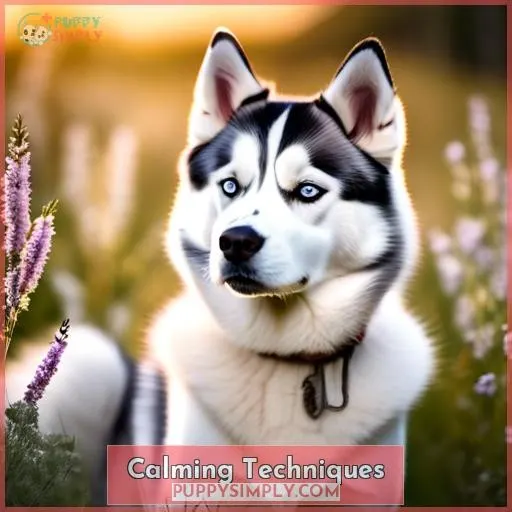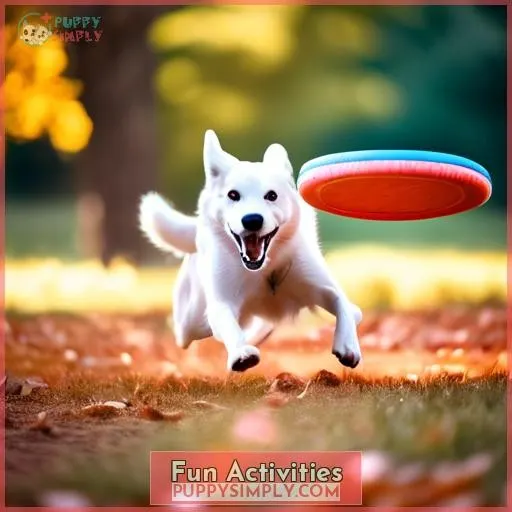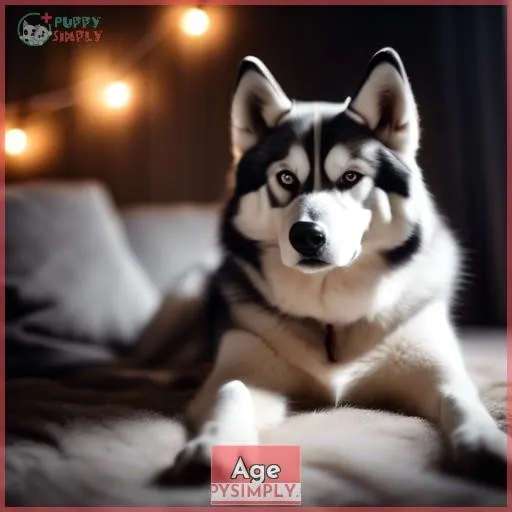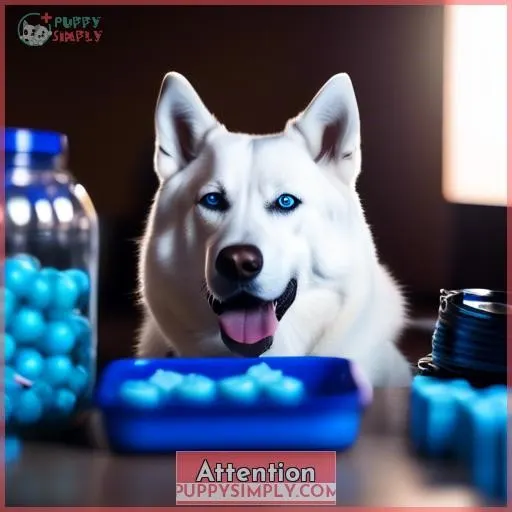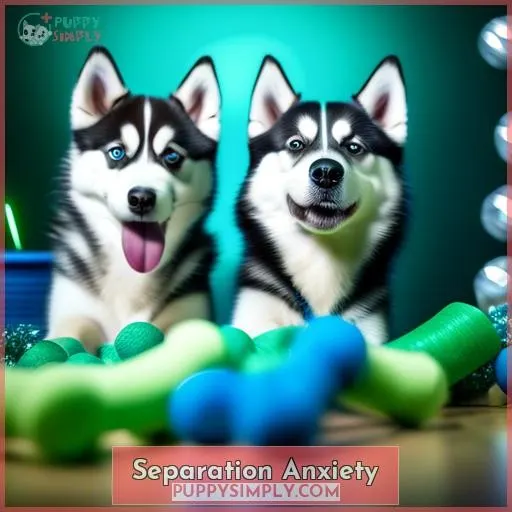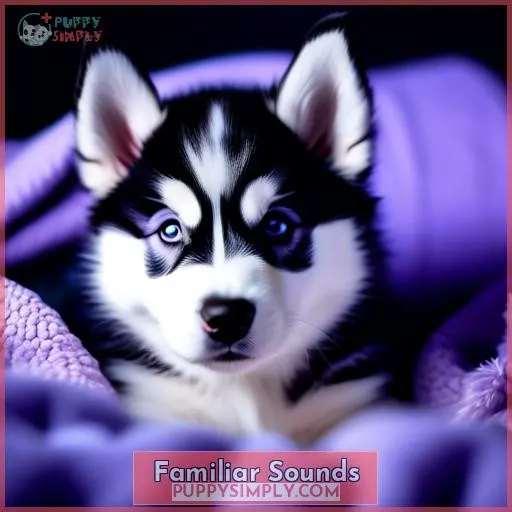This site is supported by our readers. We may earn a commission, at no cost to you, if you purchase through links.

Their boundless enthusiasm can be exhilarating, yet exhausting.
If you’re struggling to tame your hyper husky, you’re not alone.
This article delves into the world of hyper huskies, exploring five calming tools to help you navigate their boundless energy.
From exercise and routine to training and environmental adjustments, discover strategies to help your husky find their inner peace, and transform your home from a whirlwind of chaos to an oasis of tranquility.
Table Of Contents
- Key Takeaways
- Why Are Huskies Hyper?
- Calming Techniques
- Professional Help
- Fun Activities
- Age
- Attention
- Separation Anxiety
- Comfortable Place
- Familiar Sounds
- Frequently Asked Questions (FAQs)
- Can a hyperactive husky’s behavior be linked to specific health conditions or dietary choices?
- How can I distinguish between normal puppy hyperactivity and behavioral issues that require professional intervention?
- Are there any negative consequences of using calming aids or relaxation techniques on a long-term basis?
- What preventive measures can I take to minimize hyperactivity and anxiety in my husky as it ages?
- How can I create a comprehensive calming routine that addresses my husky’s individual needs and preferences?
- Conclusion
Key Takeaways
- Proper exercise, routine, training, and a calm environment can help tame hyperactivity in huskies.
- Interactive games, outdoor adventures, indoor activities, and socialization prevent boredom and promote calmness.
- Consider seeking professional help from a veterinarian or trainer for expert advice and customized plans.
- Age-related changes in senior huskies may require adjustments in exercise and mental stimulation.
Why Are Huskies Hyper?
You’re about to embark on a journey to understand why your husky’s energy levels are on overdrive.
Huskies, with their piercing blue eyes and thick, double-layered coats, are renowned for their boundless energy and playful spirit.
But what drives their hyperactivity?
Understanding the root causes of your husky’s exuberant behavior is crucial for developing effective calming strategies.
Huskies are bred for endurance, hailing from the frigid landscapes of Siberia, where they were tasked with pulling heavy sleds over long distances.
This energetic heritage has gifted them with seemingly limitless stamina, making them prone to hyperactivity if their physical and mental needs aren’t met.
Additionally, huskies are highly intelligent and crave mental stimulation.
Without adequate opportunities to engage their minds, they may resort to destructive behaviors as an outlet for their pent-up energy.
Calming Techniques
To help your hyperactive husky find their calm, focus on:
- Exercise: Daily physical activity helps burn off energy and release endorphins.
- Routine: A consistent routine provides stability and predictability.
- Training: Training your husky to obey commands and behave appropriately will give them a sense of purpose and control, reducing hyperactivity.
- Environment: Make sure your husky has a safe and comfortable space to relax.
- Diet: Feed your husky a healthy diet that is appropriate for their age and activity level.
Exercise
Give your husky an outlet for their energy through regular exercise.
Engage them in outdoor adventures like hiking, running, or swimming.
Indoors, try playful puzzles, interactive games, and training techniques.
Socializing strategies and training techniques can provide mental stimulation and curb hyperactivity.
Routine
By creating a structured schedule with consistent feeding, playing, and walking times, you can instill a sense of predictability and security in your husky.
Daily rituals and time management are key to establishing routines that calm your dog’s hyperactivity.
Predictable days bring comfort and reduce anxiety, which in turn reduces hyperactivity.
Training
Teach your pup basic commands like sit, stay, and come, helping them learn self-control and focus.
Engage them in interactive games that challenge their minds and stimulate their natural instincts.
Use positive reinforcement and consistent boundaries to shape their behavior.
Work on leash manners to curb their excitement during walks.
By providing mental stimulation and establishing clear rules, you’ll help your hyper husky find balance and calm.
Environment
Creating a tranquil environment filled with soothing scents and sounds can aid in calming your hyperactive Husky.
Use aromatherapy to infuse your home with calming scents like lavender or chamomile.
Engage their senses with behavioral puzzles and interactive toys that stimulate their minds and help them relax.
Visual harmony is key – ensure your Husky’s space is free of clutter and has calming colors.
Diet
.
Professional Help
You’re likely eager to learn more about professional help for your hyperactive Husky.
We’ll explore how a veterinarian and trainer can work together to develop a personalized plan for your dog’s specific needs, helping it lead a calmer, more balanced life.
Vet
If you’ve tried everything you can think of, and your husky’s hyperactivity persists, it’s time to take them to the vet.
Veterinary professionals can:
- Evaluate your dog’s behavior
- Rule out medical issues
- Provide expert advice
They may recommend:
- Behavior medication
- Holistic approaches
- Integrative solutions to address anxiety triggers and reactivity
Don’t let your husky’s hyperactivity control your life—seek professional help today.
Trainer
Consulting a trainer after seeking veterinary advice can be a productive step towards alleviating your husky’s hyperactivity.
Their expertise offers trainer insights into effective methods and behavioral techniques.
They’ll craft customized plans tailored to your husky’s needs, providing ongoing support to ensure lasting results.
Fun Activities
Harness your Husky’s energy with interactive games and stimulating toys.
Stash away a cache of balls, ropes, and chew toys to satisfy their innate need to bite, chew, and chase.
Engage your Husky’s curious mind with puzzle toys that challenge their intellect.
Take your Husky on outdoor adventures, from hiking trails to dog parks, to burn off excess energy and stimulate their senses.
Arrange indoor games like hide-and-seek or fetch to keep them active and entertained.
Enroll your Husky in enrichment workshops or socialization outings to engage their minds and provide opportunities for positive interactions.
These activities not only tame their wild spirit but also strengthen your bond and prevent destructive behaviors stemming from boredom and anxiety.
Age
Older huskies tend to exhibit calmer behavior compared to their puppy or adolescent counterparts.
Their youthful exuberance wanes, replaced by a serene wisdom that comes with age.
However, this doesn’t mean your senior husky is immune to hyperactivity.
Just like humans, dogs experience physical and mental changes as they age.
Their bodies may not be as agile as they once were, and their minds may be more prone to anxiety.
Providing your aging husky with senior support is essential for their well-being.
Adapt their exercise routine to accommodate their reduced energy levels, and make sure they have a comfortable place to rest and relax.
Mental stimulation is also crucial for elderly engagement.
Interactive toys and gentle training sessions can help keep their minds sharp and prevent boredom.
Attention
While age may be a factor, you can also curb your husky’s hyperactivity by giving them the attention they crave.
Huskies are pack animals who thrive on companionship and interaction. Make time each day to play with your husky, take them for walks, or simply cuddle up on the couch. This one-on-one time will help them feel loved and secure, reducing their need to act out.
Engage your husky mentally as well as physically. Huskies are intelligent dogs who need mental stimulation to stay happy and healthy. Provide them with interactive toys, puzzle feeders, or play games of fetch or hide-and-seek.
These activities will help them focus their energy and reduce boredom, making them less likely to misbehave.
Separation Anxiety
Your husky’s separation anxiety can be eased with a familiar routine.
Stick to consistent feeding, walking, and playtime schedules to create a sense of predictability and security.
Cope with Triggers:
- Identify your husky’s anxiety triggers, whether it’s being left alone, specific noises, or changes in routine.
- Gradually desensitize your dog to these triggers by exposing them in a controlled manner while providing positive reinforcement.
Behavioral Modification:
- Work with a trainer to implement behavior modification techniques.
- This may involve counterconditioning, where you pair positive experiences with the anxiety-provoking situation, or systematic desensitization, where you gradually expose your dog to the trigger while they’re in a relaxed state.
Relaxation Techniques:
- Teach your husky relaxation techniques like deep breathing exercises or progressive muscle relaxation.
- You can also try calming aids like pheromone diffusers or music therapy to create a soothing environment.
Supportive Routines:
- Establish supportive routines that help your husky feel safe and secure.
- This includes providing a comfortable and quiet space for them to retreat to, playing calming music, and engaging in regular grooming sessions, which can have a calming effect.
Comfortable Place
Give your husky a calming den-like space to relax, play, and unwind without intrusions.
This Cozy Corner can be a crate, a dog bed in a quiet corner, or even a dedicated room.
Ensure it’s equipped with a soft Cushion Calmness, a cozy blanket, and their favorite toys.
This Serene Spot will become their Relaxation Retreat, a place where they can escape the hustle and bustle of household changes.
By providing this Tranquil Nook, you’re not just giving your husky a place to rest, you’re giving them a sense of security and control.
This can go a long way in reducing their hyperactivity and anxiety.
Familiar Sounds
By surrounding your husky with familiar sounds, you can help create a sense of security and comfort, reducing hyperactivity and anxiety.
White noise, calming playlists, ambient sounds, and soothing melodies can all be used to create a relaxing atmosphere for your dog.
These sounds can help mask startling noises and provide a sense of familiarity, especially in new or unfamiliar environments.
Playing calming music or nature sounds can also help soothe your husky’s nerves and promote relaxation.
Additionally, exposing your dog to familiar sounds associated with positive experiences, such as the sound of your voice or the jingle of its leash before a walk, can help create a sense of anticipation and excitement, reducing hyperactivity and promoting calmness.
Frequently Asked Questions (FAQs)
Can a hyperactive husky’s behavior be linked to specific health conditions or dietary choices?
Yes, your husky’s hyperactivity may stem from underlying health issues or dietary choices.
Consider consulting a veterinarian to rule out medical causes.
Adjust their diet to exclude potential triggers.
How can I distinguish between normal puppy hyperactivity and behavioral issues that require professional intervention?
When should puppy high jinks raise concern?
Differentiate normal exuberance from concerning behaviors requiring expert guidance.
- Normal exuberance:
- Playful behavior
- Bouncing and jumping
- Chasing and wrestling
- Barking and howling
- Concerning behaviors:
- Destructive behavior
- Aggression towards people or animals
- Excessive barking or howling
- Fearfulness or anxiety
- Compulsive behaviors
Are there any negative consequences of using calming aids or relaxation techniques on a long-term basis?
Long-term use of calming aids or relaxation techniques generally poses no adverse effects.
However, it’s crucial to address the underlying cause of your dog’s hyperactivity or anxiety.
Consult your veterinarian for personalized guidance and potential alternatives.
What preventive measures can I take to minimize hyperactivity and anxiety in my husky as it ages?
Consider implementing a regular exercise routine to help manage your husky’s energy levels and prevent hyperactivity as it ages.
Such as a 30-minute walk or run each morning.
How can I create a comprehensive calming routine that addresses my husky’s individual needs and preferences?
Craft a holistic calming routine tailored to your husky’s unique needs and preferences:
- Exercise: Provide regular physical activity to release pent-up energy. Consider activities like long walks, fetch, or agility training.
- Mental Stimulation: Engage your husky’s mind with interactive toys, puzzle feeders, or training sessions.
- Environmental Adjustments: Create a calming environment by providing a quiet space, using calming scents like lavender, and avoiding loud noises or sudden movements.
- Natural Calming Aids: Consult your veterinarian about natural calming aids like chamomile, valerian root, or melatonin.
Conclusion
Embracing these calming strategies can help you create a more harmonious home environment for you and your hyper husky.
With time and dedication, you’ll transform your home from a whirlwind of chaos to an oasis of tranquility, allowing you both to enjoy a peaceful and fulfilling companionship.
The hyper husky of today can become the calm and composed canine companion you’ve always dreamed of.


